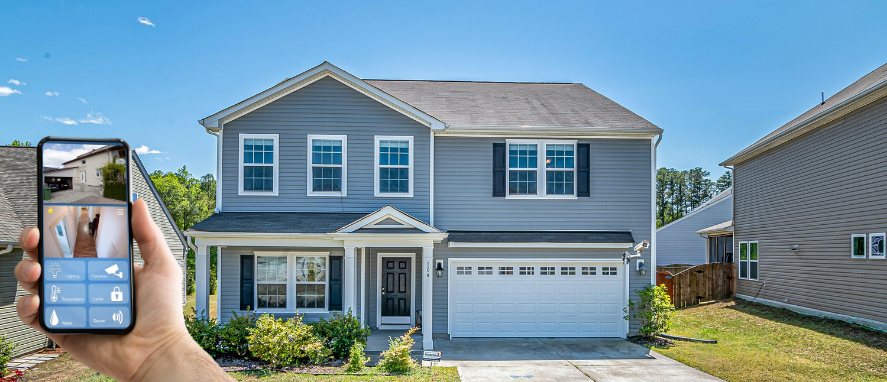- Careers |
- Latest News |
- Mississauga, Ontario
- +1 236 332 3880
- info@alarm24hours.com
- +1 236 332 3880
- info@alarm24hours.com

Secure Your Space: The Ultimate Guide to Installing Home Security Cameras in Mississauga
In today's world, ensuring the safety of your home is more important than ever. With rising property crimes and the evolution of smart technology, installing security cameras has become an essential part of home security in Mississauga. According to recent market research, the smart home security camera market is experiencing unprecedented growth, projected to reach $15.46 billion by 2034. Whether you want to deter potential intruders, monitor your property remotely, or simply enhance your peace of mind, a well-planned security camera system can make all the difference.
This guide will walk you through the essential steps of installing home security cameras in Mississauga, covering everything from choosing the right equipment to ensuring proper placement and maintenance.
Legal Requirements and Compliance:
Before diving into installation, it's crucial to understand the legal framework. In Mississauga and across Canada, homeowners are permitted to install security cameras on their property, but there are important guidelines to follow:
• All cameras must be mounted within your property boundaries.
• Cameras should be positioned to monitor only your property.
• Avoid pointing cameras directly at neighbours' properties.
• Clearly visible cameras are preferred over hidden ones.
• Crime Deterrence: Visible cameras discourage burglars and trespassers.
• Remote Monitoring: Modern systems allow homeowners to check their property from anywhere.
• Evidence Collection: In case of an incident, recorded footage can be crucial for investigations.
• Insurance Benefits: Some insurance providers offer discounts for homes equipped with security systems.
Mississauga, like any urban area, experiences property-related crimes. Installing security cameras can significantly reduce the risk and provide homeowners with a sense of security.
Selecting the right security camera system depends on various factors:
1. Type of Cameras:
• Wired vs. Wireless: Wired cameras offer stable connections, while wireless cameras provide flexibility.
• Indoor vs. Outdoor: Outdoor cameras should be weather-resistant.
• Motion-Activated vs. Continuous Recording: Motion-activated cameras save storage space.
2. Resolution & Night Vision:
• Opt for high-definition (HD) or 4K cameras for clear footage.
• Infrared night vision ensures visibility in low-light conditions.
3. Storage Options:
• Cloud Storage: Accessible remotely but may require a subscription.
• Local Storage: DVR or NVR systems store footage on hard drives.
4. Smart Features:
• AI-powered motion detection.
• Two-way audio communication
• Integration with smart home systems.
1. Planning & Placement:
• Identify vulnerable areas such as entry points, driveways, and backyards.
• Ensure cameras cover wide angles without obstructions.
2. Mounting the Cameras:
• Use sturdy mounts to prevent tampering.
• Position cameras at least 8-10 feet above ground.
3. Connecting to Power & Network:
• Wired cameras require proper cable management.
• Wireless cameras need a stable Wi-Fi connection.
4. Configuring the System:
• Set up recording preferences.
• Enable motion alerts and remote access.
5. Testing & Adjustments:
• Check video quality and adjust angles.
• Ensure night vision functionality.
• Set Up the Camera: Connect the camera to your Wi-Fi network using the app provided by the manufacturer.
• Choose a Location: Mount the camera on a stable surface using the provided brackets.
• Angle the Camera: Adjust the camera to capture the desired field of view.
• Test the System: Verify live video feed and motion detection.
• Plan the Wiring: Run cables from the camera to the power source and recording device.
• Drill and Secure: Mount the camera using screws and secure the cables with clips.
• Connect to Power: Plug the camera into an outlet or power source.
• Test the System: Confirm video recording and playback functionality.
Regular maintenance ensures optimal performance:
• Clean lenses to prevent blurry footage.
• Check connections for wired systems.
• Update firmware for security patches.
• Test storage capacity to avoid data loss.
Common troubleshooting tips:
• Fix connectivity issues by rebooting routers.
• Resolve blurry images by adjusting focus settings.
• Ensure night vision works by checking infrared sensors.
Installing home security cameras in Mississauga is a proactive step toward safeguarding your property. By choosing the right system, following proper installation procedures, and maintaining your equipment, you can enhance your home’s security effectively. Whether you opt for a DIY setup or professional installation, investing in a reliable surveillance system ensures peace of mind for you and your family.
Would you like recommendations for security camera providers in Mississauga? I can help with that!